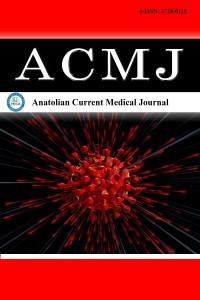The risk of bleeding complications on percutaneous biliary drainage in patients with abnormal hemostasis
The risk of bleeding complications on percutaneous biliary drainage in patients with abnormal hemostasis
___
- Saad WE, Wallace MJ, Wojak JC, Kundu S, Cardella JF. Quality improvement guidelines for percutaneous transhepatic cholangiography, biliary drainage, and percutaneous cholecystostomy. J Vasc Interv Radiol 2010; 21: 789–95.
- Kühn JP, Busemann A, Lerch MM, et al. Percutaneous biliary drainage in patients with nondilated intrahepatic bile ducts compared with patients with dilated intrahepatic bile ducts. AJR Am J Roentgenol 2010; 195: 851-7.
- Uberoi R, Das N, Moss J, Robertson I. British Society of Interventional Radiology: Biliary Drainage and Stenting Registry (BDSR). Cardiovasc Intervent Radiol 2012; 35: 127–38.
- Patel, IJ, Davidson JC, Nikolic B, et al. consensus guidelines for periprocedural management of coagulation status and hemostasis risk in percutaneous image-guided interventions. J Vasc Intervent Radiol 2012; 23: 727 -36.
- Choi SH, Gwon DI, Ko GY, et al. Hepatic arterial injuries in 3110 patients following percutaneous transhepatic biliary drainage. Radiology 2011; 261: 969-75.
- Tapping CR, Byass OR, Cast JE. Percutaneous transhepatic biliary drainage (PTBD) with or without stenting—complications, re-stent rate and a new risk stratification score. Eur Radiol 2011; 21: 1948–55.
- Rivera-Sanfeliz GM, Assar OS, LaBerge JM, et al. Incidence of important hemobilia following transhepatic biliary drainage left sided versus right sided approaches. Cardiovasc Intervent Radiol 2004; 27: 137-9.
- Özdemir A, Şahan MH. Ultrasonografi rehberliğinde perkütan kesici karaciğer biyopsisi (parankim ve lezyon): klinik deneyimimiz. Kırıkkale Üniversitesi Tıp Fakültesi Derg 2019; 21: 325-31.
- Houghton EJ, Zeledón M, Acquafresca P, Finger C, Palermo M, Giménez ME. Prospective comparison of bleeding complications between right and left approaches in percutaneous biliary drainage. Surg Laparosc Endosc Percutan Tech 2019; 29: 7–12.
- Wiltrout C, Kondo K. Correction of coagulopathy for percutaneous interventions. Semin Intervent Radiol 2010; 27: 338–47.
- Donkol RH, Latif NA, Moghazy K. Percutaneous imaging-guided interventions for acute biliary disorders in high surgical risk patients. World J Radiol 2010; 28: 358-67.
- Garcarek J, Kurcz J, Guziński M, et al. Ten years single center experience in percutaneous transhepatic decompression of biliary tree in patients with malignant obstructive jaundice. Adv Clin Exp Med 2012; 2: 621-32.
- L’Hermine C, Ernst O, Delemazure O, et al. Arterial complications of percutaneous transhepatic biliary drainage. Cardiovasc Intervent Radiol 1996; 19: 160–4.
- Houghton EJ, Invernizzi E, Acquafresca P, Palermo M, Giménez ME. Risk of bleeding complications in percutaneous biliary drainage: the paradox of the normal hemostasis. Arq Bras Cir Dig 2019; 21:e1454.
- Navin PJ, White ML, Nichols FC, et al. Periprocedural major bleeding risk of image-guided percutaneous chest tube placement in patients with an elevated international normalized ratio. J Vasc Interv Radiol 2019; 30: 1765-8.
- Martin JH, Rosser CJ, Linebach RF, McCullough DL, Assimos DG. Are coagulation studies necessary before percutaneous nephrostomy? Tech Urol 2000; 6: 205–7.
- Fisher NC, Mutimer DJ. Central venous cannulation in patients with liver disease and coagulopathy—a prospective audit. Intens Care Med 1999; 25: 481–5.
- Quencer K, Tadros A, Marashi K, et al. Bleeding after percutaneous transhepatic biliary drainage: incidence, causes and treatments. J Clin Med 2018; 7: 94.
- Nennstiel S, Weber A, Frick G, et al. Drainage-related complications in percutaneous transhepatic biliary drainage an analysis over 10 years. J Clin Gastroenterol 2015; 49: 764-70.
- Haas B, Trerotola S, Itkin M, et al. Tunneled central venous catheter insertion in patients with coagulopathy and thrombocytopenia. J Vasc Interv Radiol 2009; 20: 35–6.
- Haas B, Chittams JL, Trerotola SO. Large-bore tunneled central venous catheter insertion in patients with coagulopathy. J Vasc Interv Radiol 2010; 21: 212–7.
- Malloy PC, Grassi CJ, Kundu S, et al. Consensus guidelines for periprocedural management of coagulation status and hemostasis risk in percutaneous image-guided interventions. J Vasc Interv Radiol 2009;20: 240–9.
- Stecker MS, Johnson MS, Ying J, et al. Time to hemostasis after traction removal of tunneled cuffed central venous catheters. J Vasc Interv Radiol 2007; 18: 1232–9.
- Yayın Aralığı: 6
- Başlangıç: 2019
- Yayıncı: MediHealth Academy Yayıncılık
Childhood renal tumors: surgical treatment and results
Can İhsan ÖZTORUN, Süleyman Arif BOSTANCI, Ahmet ERTÜRK, Gökhan DEMİRTAŞ, Doğuş GÜNEY, Sabri DEMİR, Elif Emel ERTEN, Derya ÖZYÖRÜK, Gülsen KESKİN, Müjdem AZILI, Fatih AKBIYIK, Bilge KARABULUT, Tuğrul TİRYAKİ, Emrah ŞENEL
Is laparoscopic ventral rectopexy a good treatment option for rectal prolapse?
Tezcan AKIN, Sadettin ER, Hüseyin BERKEM, Erdinç ÇETİNKAYA, Elif Nur GENCER, Gizem GÜNEŞ, Ahmet Keşşaf AŞLAR, Bülent Cavit YÜKSEL
Şeyma EŞKİ, Hasret YALÇINÖZ BAYSAL
Is USG-guided aspiration more effective than physiotherapy in the treatment of Baker’s cyst?
Nurmuhammet TAŞ, Hülya UZKESER, Akın ERDAL
Hacer KAYHAN KAYA, Abdurrahman ŞERMET, Zafer PEKKOLAY, Ezel TAŞDEMİR, Dilek AYGÜN KEŞİM
Musa ZENGİN, Ramazan BALDEMİR, Gülay ÜLGER, Hilal SAZAK, Ali ALAGÖZ
Ramazan BALDEMİR, Güler ERASLAN DOĞANAY
Özlem DEMİRCİOĞLU, Canan ÇİMŞİT, Cagatay ÇİMŞİT
Kubilay SARIKAYA, Çağri ŞENOCAK, Muhammed Arif İBİŞ, Fahri Erkan SADİOĞLU, Mehmet ÇİFTÇİ, Ömer Faruk BOZKURT
The frequency of vitamin D deficiency in Ordu and its relationship with chronic diseases
